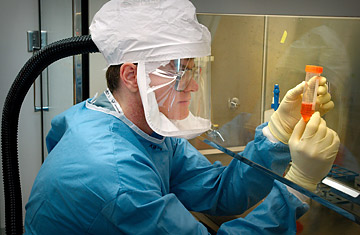
A doctor at the Centers for Disease Control examines specimens in an effort to develop new influenza vaccines
World health officials are carefully watching the H1N1/09 swine-flu virus as it makes its way through the Southern Hemisphere, which is currently in the thick of its flu season. They are particularly interested in seeing how severely the virus affects infected people in parts of Africa, South America and Australia, since their illnesses could be a good predictor of how aggressive the virus will be when flu season returns to the rest of the world in the fall.
So far, the H1N1/09 flu appears to be mild overall and treatable with existing antiviral therapies. But given that the virus continues to cause some serious cases of illness and death, the U.S. Centers for Disease Control and Prevention (CDC) isn't taking any chances. On Wednesday, July 29, the agency called an urgent meeting of its Advisory Committee on Immunization Practices, which decides who gets vaccinated against which diseases and when. The committee was asked to generate guidelines for H1N1/09 vaccination, if and when the agency determines that such immunizations become necessary, in addition to those for seasonal flu.
The 15-member panel of doctors, scientists, vaccine experts, public-health officials and a citizen representative came up with five core populations they believe should receive the first wave of H1N1/09 immunization. These include pregnant women, people living in households with babies under 6 months old (since infants cannot be immunized, they must be protected by preventing illness in those around them), emergency medical personnel who are likely to be in contact with infected patients, young people between 6 months and 24 years old, and nonelderly individuals who have underlying conditions, such as asthma, respiratory illness or a compromised immune system, that put them at higher risk of flu complications.
Notably absent from the target list are the elderly, those over age 65, who are generally considered a high-risk group when it comes to seasonal influenza. Based on the populations who were hardest hit by H1N1/09 last spring, first in Mexico and then across other continents, CDC experts believe that the elderly will not be as vulnerable to H1N1/09 in the fall as younger adults might be. In fact, health officials have relegated the elderly to the back of the line for H1N1/09 vaccinations — after the five target groups have received their shots, the next eligible group would be younger, healthy adults who have no underlying medical conditions that would complicate the flu. Only after those populations have been inoculated would the elderly be permitted to receive vaccination. "People who are 65 and over are at high risk of influenza complications from seasonal influenza," Dr. Anne Schuchat, director of the CDC's National Center for Immunization and Respiratory Disease, told reporters on Wednesday. "It's important that they get the seasonal-flu shot. But the H1N1 outbreaks have so far spared that population. So I would tell them that their risk of illness from this virus is very low compared to that of younger people."
That could still change, but at least for now, says Schuchat, local and state health authorities will have some guidelines for deciding who should get vaccinated if it becomes necessary. That could be useful since initial lots of the vaccine, which will have to be given in two doses, may not be sufficient to vaccinate everyone who wants it; some targeting of the first shots will be necessary. Manufacturers around the world are currently preparing and testing vaccines — the first are expected to be ready in October — but Schuchat stressed on Wednesday that the CDC has not yet decided whether it will recommend H1N1/09 vaccination at all.
